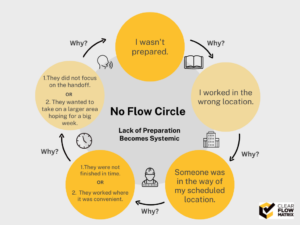Tired of Running in Circles?
Balance Your Way Out!
Coordination issues on a construction site can spread like wildfire, compounding each other until site supervision is caught up and the No Flow Circle commences! For those of you wondering, the No Flow Circle is the inevitable outcome that will always result when production is not balanced and the driving focus for any job relies more on schedule dates than production rates.
It looks something like this…

In this kind of a mindset, frustrations build and create more inefficiencies that inevitably serve to disrupt the trade partner’s planning and the lack of preparation becomes a systemic roadblock to progress.
How Do You Break the Circle?
Understanding the flow for your particular job allows the focus to shift to the balanced production front, resulting in a (diagonal) line of steady momentum forward and a break in the No Flow Circle.

What Makes It So Difficult?
In a word (or two): Human tendency. Since the 1980’s we have depended on subcontractors to focus on cost efficiency and used CPM methods to manage specific deadlines we think will maintain project schedules. Both methods completely ignore project flow. The level of disruption has become systemic to the point that trade partners defend their approach and do not trust balanced flow or balanced production. And this is a real problem because of what it has done to our direct work ratios!
After decades struggling with the No Flow Circle, the percentage of direct work on construction sites has decreased from 50% in the 1970’s, to 35% to 40% currently.

CFMx: Your Solution for Linear Progress
Using the Clear Flow Matrix (CFMx), trade partners are able to focus on both flows (process and operations), enabling them to balance process handoffs and allow for the pace of production to return. There is clear direction to their preparation efforts and sustainable flow is the logical result.
Focus can then be directed to ensuring work is completed at the right place and at the right time, resulting in smaller handoffs, smaller crews, and reduced variation. This then restores the 50% direct work average by returning to the methods used when trade foremen and job superintendents successfully managed with production rates versus schedule dates.

Break the Circle!

Recent Comments